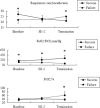The experience of high-flow nasal cannula in hospitalized patients with 2019 novel coronavirus-infected pneumonia in two hospitals of Chongqing, China
- PMID: 32232685
- PMCID: PMC7104710
- DOI: 10.1186/s13613-020-00653-z
The experience of high-flow nasal cannula in hospitalized patients with 2019 novel coronavirus-infected pneumonia in two hospitals of Chongqing, China
Abstract
Background: The outbreak of a novel coronavirus (2019-nCoV)-infected pneumonia (NCIP) is currently ongoing in China. Most of the critically ill patients received high-flow nasal cannula (HFNC) oxygen therapy. However, the experience of HFNC in this population is lacking.
Methods: We retrospectively screened 318 confirmed patients with NCIP in two hospitals of Chongqing, China, from January 1st to March 4th, 2020. Among them, 27 (8.4%) patients experienced severe acute respiratory failure including 17 patients (63%) treated with HFNC as first-line therapy, 9 patients (33%) treated with noninvasive ventilation (NIV) and one patient (4%) treated with invasive ventilation. HFNC failure was defined by the need of NIV or intubation as rescue therapy.
Results: Of the 17 HFNC patients, 7 (41%) experienced HFNC failure. The HFNC failure rate was 0% (0/6) in patients with PaO2/FiO2 > 200 mm Hg vs. 63% (7/11) in those with PaO2/FiO2 ≤ 200 mm Hg (p = 0.04). Compared with baseline data, the respiratory rate significantly decreased after 1-2 h of HFNC in successful group [median 26 (IQR: 25-29) vs. 23 (22-25), p = 0.03]. However, it did not in the unsuccessful group. After initiation of NIV as rescue therapy among the 7 patients with HFNC failure, PaO2/FiO2 significantly improved after 1-2 h of NIV [median 172 (150-208) mmHg vs. 114 (IQR: 79-130) under HFNC, p = 0.04]. However, two out of seven (29%) patients with NIV as rescue therapy ultimately received intubation. Among the 27 patients with severe acute respiratory failure, four patients were eventually intubated (15%).
Conclusions: Our study indicated that HFNC was the most common ventilation support for patients with NCIP. Patients with lower PaO2/FiO2 were more likely to experience HFNC failure.
Keywords: Coronavirus; High-flow nasal cannula; Pneumonia.
Conflict of interest statement
We declare that we have no competing interests.
Figures
References
Grants and funding
LinkOut - more resources
Full Text Sources




